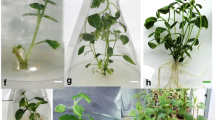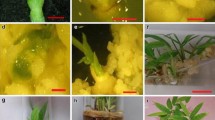Abstract
An efficient planlet regeneration system via nodular callus formation is described for Pinus radiata. Subculturable nodular callus was induced at its highest frequency (93%) on embryonic explants excised from seeds at an early stage of germination (radicle length 2–5 mm). The optimal medium for nodular callus tissue proliferation was \(\frac{1}{2}\) LP basal medium that was modified by reducing the concentration of potassium nitrate to 500 mg l−1 and supplemented with 22.2 μM 6-benzyladenine (BAP) and 2.85 μM indole-3-butyric acid (IBA). Bud differentiation from the nodules was achieved by reducing BAP and sucrose concentrations in the culture medium. The maximum frequency of adventitious bud formation occurred on \(\frac{1}{2}\) LP basal medium containing 2% sucrose and 0.44 μM BAP on which about 61% of the transferred nodules formed buds. During the next 6 weeks of culture on the same cytokinin-free medium multiple shoots elongated from the buds. These shoots were excised and transferred to root initiation medium (RIM2.1), consisting of full-stregth SH macro- and micro-salts, 1000 mg l−1 myo-inositol, 0.4 mg l−1 thiamine-HCl, 2% sucrose and a combination of naphthaleneacetic acid (NAA), IBA and BAP at concentrations of 2.69, 4.93 and 0.11 μM, respectively. After 5–15 days, root meristems were initiated on the stem bases. The highest rooting frequency was achieved when shoots were treated for 10 days on RIM2.1 medium, before being transferred to half-strength Schenk and Hildebrandt medium with 1% sucrose and without growth regulators for root growth.
Similar content being viewed by others
References
Abdullah A & Grace J (1987) Regeneration of calabrian pine from juvenile needles. Plant Sci. 53: 147-155
Aitken J, Horgan K & Thorpe T (1980) Influence of explant selection on the shoot-forming capacity of juvenile tissue of Pinus radiata. Can. J. For. Res. 11: 112-117
Aitken-Christie J, Singh A & Davies H (1986) Multiplication of meristematic tissue: a new tissue culture system for radiata pine. In: Bajaj YPS (ed) Biotechnology in Agriculture and Forestry, Vol 1, Trees I (pp. 413-432). Berlin/Heidelberg/New York/Tokyo
Becwar M, Nagmani R & Wann S (1990) Initiation of embryogenic cultures and somatic embryo development in loblolly pine (Pinus taeda). Can. J. For. Res. 20: 810-817
Bergmann B & Stomp A (1992) Influence of taxonomic relatedness and medium composition on meristematic nodule and adventitious shoot formation in nine pine species. Can. J. For. Res. 22: 750-755
Bozhkov P, Mikhlina S, Shiryaeva G & Lebedenko L (1993) Influence of nitrogen balance of culture medium on norway spruce (Picea abies L. Karst) somatic polyembryogenesis: high frequency establishment of embryonal-su0spensor mass lines from mature zygotic embryos. J. Plant Physiol. 142: 735-741
Garcia-Ferriz L, Serrano L & Pardos J (1994) In vitro shoot organogenesis from excised immature cotyledons and microcuttings production in stone pine. Plant Cell Tiss. Org. Cult. 36: 135-140
Horgan K & Aitken J (1981) Reliable plantlet formation from embryos and seedlings shoot tips of radiata pine. Physiol. Plant 53: 170-175
Huang Y, Diner A & Karnosky D (1991) Agrobacterium rhizogenes-mediated genetic transformation and regeneration of a conifer: Larix deciduas. In Vitro Cell. Dev. Biol. 27P: 201-207
Jain MS (1999) Somatic embryogenesis in forest trees. In: Espinel S & Ritter E (eds) Proceedings of Applications of Biotechnology to Forest Genetics, Biofor99. (pp. 173-188). 22-25 September, Vitoria-Gasteiz, Spain
Kaul K & Kochhar T (1985) Growth and differentiation of callus cultures of Pinus. Plant Cell Rep. 4: 180-183
Lelu M, Bastien C, Klimaszewska K, Ward C & Charest P (1994) An improved method for somatic plantlet production in hybrid larch (Larix leptoeuropaea): Part 1. Somatic embryo maturation. Plant Cell Tiss. Org. Cult. 36: 107-115
Li X, Huang F, Murphy J & Gbur E (1998) Polyethylene glycol and maltose enhance somatic embryo maturation in loblolly pine. In Vitro Cell. Dev. Biol. 34: 22-26
Park YS, Barrett JD & Bonga JM (1998) Application of somatic embryogenesis in high-value clonal firestry: deployment, genetic control, and stability of cryoperserved clones. In Vitro Cell. Dev. Biol. 34: 231-239
Reilly K & Washer J (1977) Vegetative propagation of radiata pine by tissue culture: plantlet formation from embryonic tissue. N. Z. J. For. Sci. 2: 199-206
Saborio F, Dvorak W, Donahue J & Thorpe T (1997) In vitro regeneration of plantlets from mature embryos of Pinus ayacahuite. Tree Physiol. 17: 787-796
Schenk RU & Hildebrandt AC (1972) Medium and techniques for induction and growth of monocotyledonous and dicotiledonous plant cell cultures. Can. J. Bot. 50: 199-204
Schuller A, Kirchner-Neß R & Reuther G (2000) Interaction of plant growth regulators and organic C and N components in the formation and maturation of Abies alba somatic embryos. Plant Cell Tiss. Org. Cult. 60: 23-31
Shestibratov KA & Dolgov SV (1999) Plant regeneration from excised cotyledons of Pinus radiata. In: Espinel S & Ritter E (eds) Proceedings of Application of Biotechnology to Forest Genetics, Biofor-99. 22-25 September, Vitoria-Gasteiz, Spain
Shin D-I, Podila G, Huang Y & Karnosky D (1994) Transgenic larch expressing genes for herbicide and insect resistance. Can. J. For. Res. 24: 2059-2067
Tang W, Ouyang F & Guo Z (1998) Plant regeneration through organogenesis from callus induced from mature zygotic embryos of loblolly pine. Plant Cell Rep. 17: 557-560
Toribio M & Pardos J (1989) Scots pine. In: Bajaj YPS (ed) Biotechnology in agriculture and forestry. V 5, Trees II (pp. 479-506). Springer-Verlag, Berlin/Heidelberg, 1989
Von Arnold S & Hakman I (1986) Plantlet regeneration in vitro via adventitious buds and somatic embryos in norway spruce (Picea abies). In: Bajaj YPS (ed) Biotechnology in agriculture and forestry, Vol 1, Trees I (pp. 199-215). Berlin/Heidelberg/New York/Tokyo
Yeung E, Aitken J, Biondi S & Thorpe T (1981) Shoot histogenesis in cotyledon explants of radiata pine. Bot. Gaz. 142: 494-501.
Author information
Authors and Affiliations
Corresponding author
Rights and permissions
About this article
Cite this article
Schestibratov, K.A., Mikhailov, R.V. & Dolgov, S.V. Plantlet regeneration from subculturable nodular callus of Pinus radiata . Plant Cell, Tissue and Organ Culture 72, 139–146 (2003). https://doi.org/10.1023/A:1022296028951
Issue Date:
DOI: https://doi.org/10.1023/A:1022296028951




